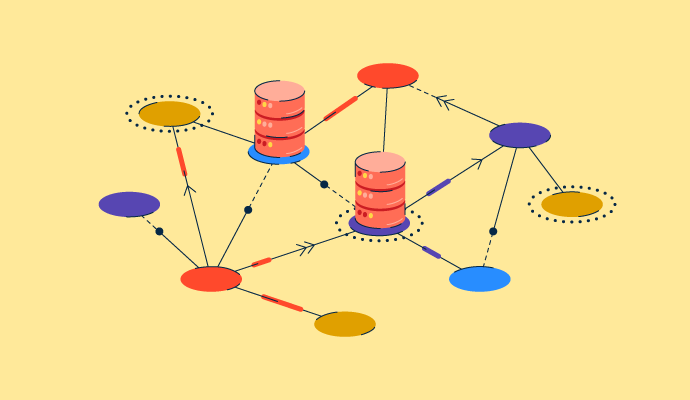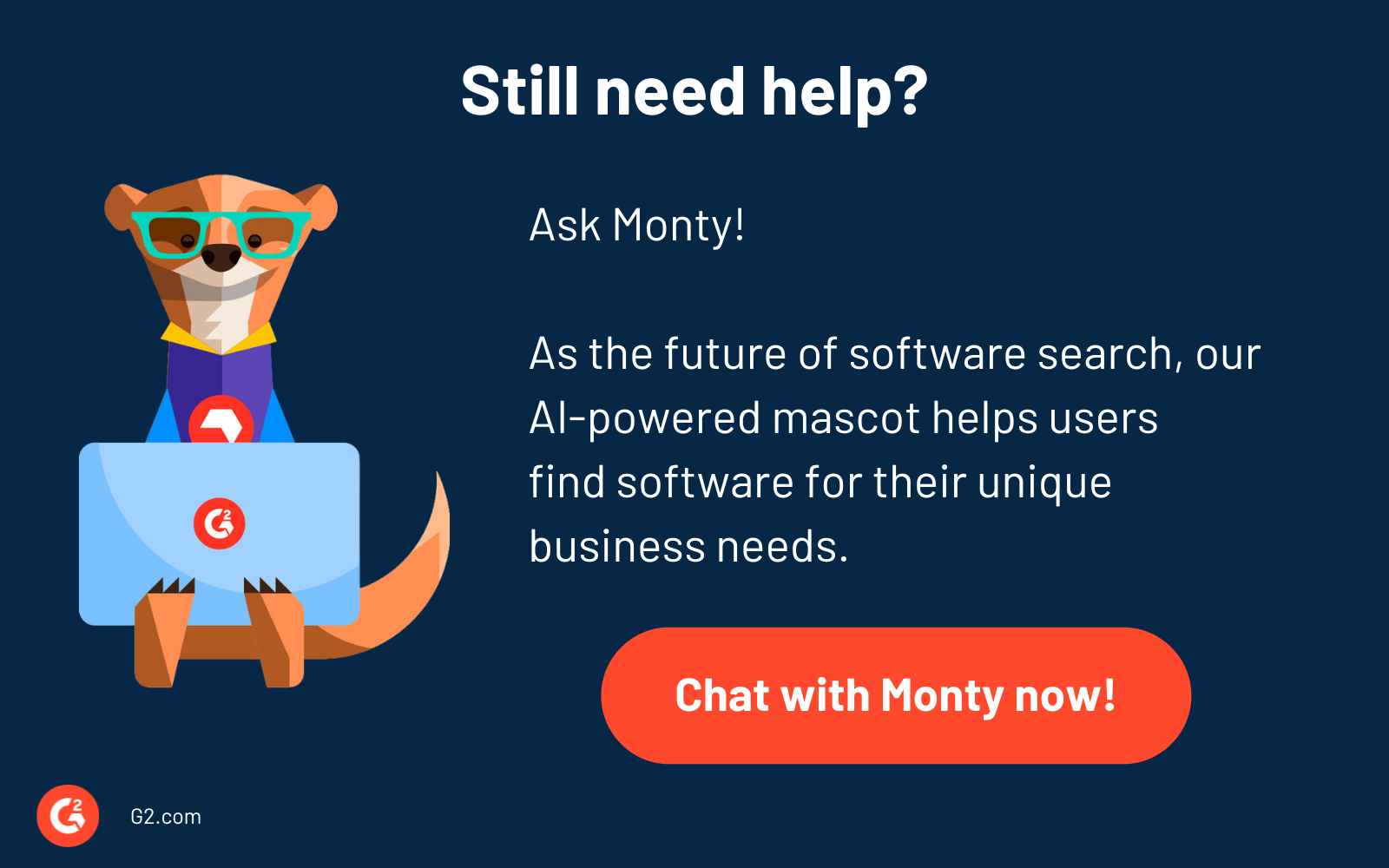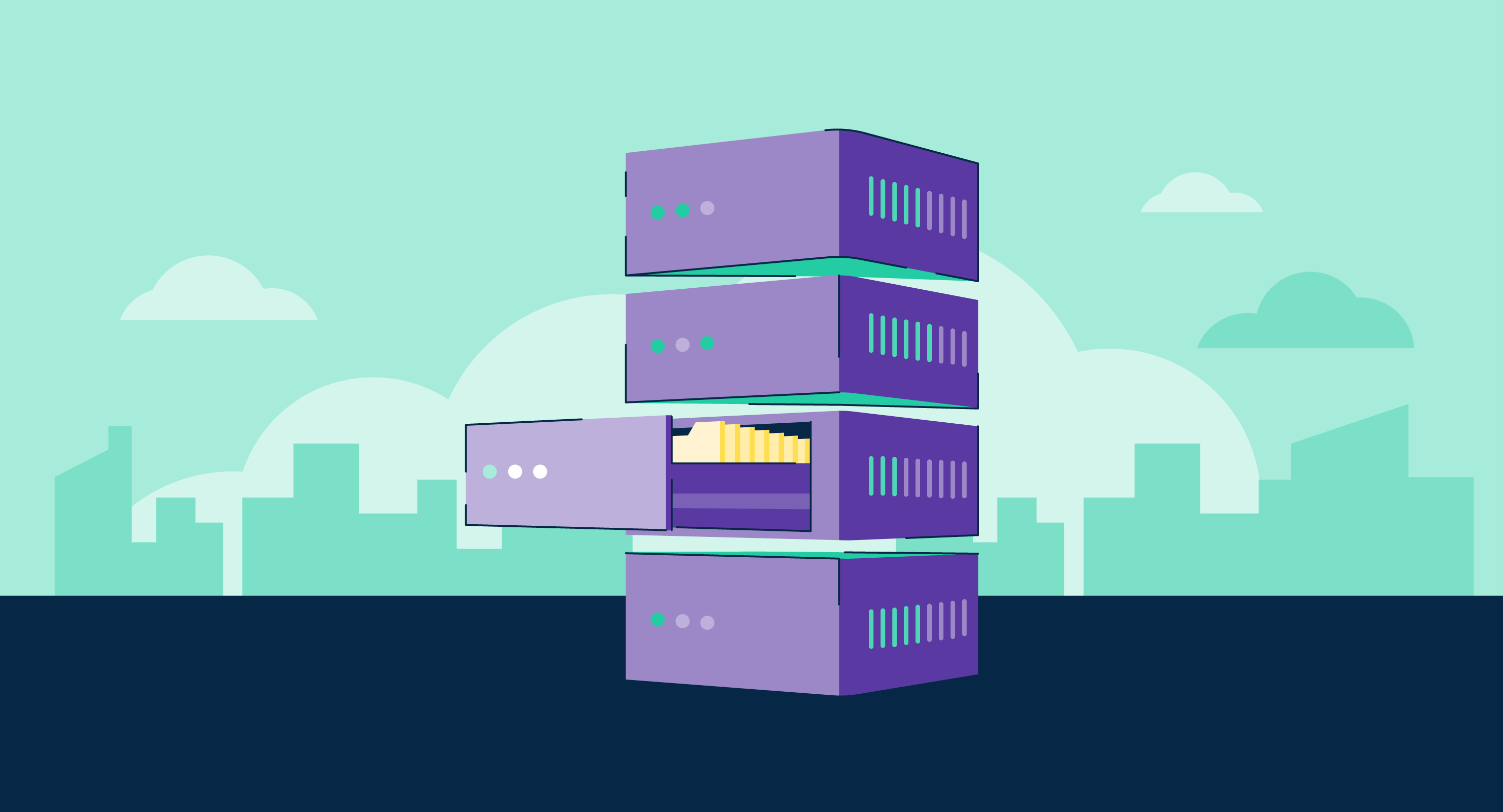Graph databases add agility and scalability to how organizations work with their data.
They store data as an interconnected network of data objects and the relationships that connect them, making it easier to scale and modify. This creates an efficient way to manage complex queries about data objects and their relations.
Best graph databases can quickly traverse and explore these connections, making them suitable for social media networks and recommendation engines. You can easily add new relationships and data and let the database adapt to your business needs.
Let’s explore graph databases in detail and understand what makes them agile.
What is a graph database?
Graph databases emphasize relations between data entities. They’re NoSQL databases that store, map, and query data relationships more efficiently than traditional databases.
They store data as a network of relationships rather than in rigid tables like relational databases do.
Graph databases have nodes that store data objects. The nodes can have unlimited relationships of different types. The relationships are represented by edges. They’ll have a start node, an end node, a type, and a direction.
Every node in a graph database has properties and attributes describing it. Such graphs are also known as property graphs.
The structure of graph databases makes it easier to discover hidden patterns and relationships in interconnected data.
Why are graph databases essential?
With the growing interconnectedness in data, relational databases take longer to respond to queries, and the data volume increases. Graph databases respond much faster. They offer many benefits, such as:
Performance improvement
When data volume increases, the connections between them increase simultaneously. Graph databases don’t flake and perform steadily despite heavy data load. Graph databases display superior resource utilization and query response time performance.
Scalable model
Graph databases let data architects keep up with business expansion. You can easily add or remove nodes to the existing data structure without disturbing the entire model, reducing the stress of creating exhaustible models with little or no modification scope.
Data integrity
Graph databases support atomicity, consistency, isolation, and durability (ACID) transactions. It means data operations are either successful or unsuccessful, avoiding partial updates that might lead to corruption. They also use a locking mechanism to prevent simultaneous updates with concurrent data access.
Some graph databases have versioning and auditing capabilities that help maintain historical data integrity.
Improved context awareness
Graph databases mirror real-world connections between data objects. They make it easy to understand relationships without going through complicated processing.
You can easily detect hidden patterns and anomalies, making them valuable assets in detecting fraud and offering more personalized recommendations.
¿Quieres aprender más sobre Bases de datos gráficas? Explora los productos de Bases de datos gráficas.
Characteristics of a graph database
Below are some qualities that make graph databases suitable for businesses that work primarily with interconnected data.
- The lack of a predefined structure makes it flexible to represent complex data relationships, helping these databases adapt to advanced data models. It makes it suitable for understanding and traversing relationships in social networks and recommendation systems.
- Native graph processing allows one to navigate through data connections quickly without the cost overheads of index lookups or join strategies. This capability is also known as index-free adjacency. Graph databases often come with a native query language. For example, Cypher for Neo4j provides an extensive syntax for interacting with graph data.
- Graph traversal and pattern matching make it easier to analyze hidden connections quickly and extract relevant data based on set criteria.
Graph database vs. relational database
Graph and relational databases use distinct data management approaches. They have their strengths and applications. Graph databases have nodes and edges, making it easier to manage and query highly interconnected data. Most of these databases offer a schema-less approach, promoting its application in dynamic data structures.
Relational databases organize data into tables with rows and columns that use a fixed schema. They’re highly efficient for simple operations, but you might face challenges scaling them when there are complex relationships between data objects.
Relational databases are suitable for traditional business applications and transaction processing.
How graph databases work
Graph databases leverage graph models to represent data relationships as nodes (vertices) and connections (edges), enabling efficient analysis of complex, interconnected data. They allow users to perform traversal queries, exploring paths, distances, and patterns between nodes to uncover insights such as communities, influencers, and anomalies.
Unlike traditional databases, graph databases explicitly store relationships, reducing the need for complex joins and enabling sub-second query performance even with massive datasets. These capabilities make them ideal for use cases like social network analysis, fraud detection, and supply chain optimization.
Graph algorithms further enhance the power of graph databases by analyzing connections to reveal patterns and behaviors. For instance, algorithms can measure the importance of nodes by examining incoming edges or the significance of neighboring nodes.
They can also identify clusters, shortest paths, and anomalies, offering deeper insights into data. By seamlessly integrating with machine learning workflows, graph databases provide a robust foundation for discovering new relationships and trends, linking disparate data sources, and uncovering hidden connections at scale.
Types of graph databases
There are a few notable types of graph databases engineers use when designing applications that rely on relationships between data objects.
Property graph databases
Like a graph database, their nodes are pointers that store data objects, and the edges represent their relationships. However, both nodes and edges have properties associated with them. These are key-value pairs that store additional data.
For example, a node can have properties like name, age, or email, while the edge contains the start date of a friendship. It represents data objects and their relationships whole, closely mirroring their real-world complexities.
You’ll likely find property graph databases’ applications in use cases like social networks or fraud detection. Use query languages like Cypher, Gremlin, or graph query language (GQL).
Resource description framework (RDF)
RDF databases specialize in handling semantic data. It includes a description of relationships between different data points. It’s ideal for use cases where data interoperability and linking are crucial. You’ll find RDF databases in applications where querying data depends on their semantic relationships.
They represent data with a subject, predicate, and object, making them preferred for querying interconnected data. You can query these databases using SPARQL Protocol and RDF Query Language (SPARQL), pronounced “sparkle,” as it allows for more sophisticated querying of data’s semantics.
Hypergraph databases
Hypergraph databases handle complex relationships with more than two entities. It allows an edge to connect to multiple nodes, making it a preferred database in computational biology or network topology where relationships involve multiple entities. These databases are extensions of typical graph databases.
Use cases of graph databases
Graph database implements a flexible and intuitive data model, emphasizing the relationships between entities. It makes them suitable for various applications like:
- Social networking: These databases help manage friends and other connections in social media apps, making it easier to find new friends and understand how they’re connected to people you know.
- Fraud detection: Banks and financial institutions spot unusual patterns that might suggest fraud using graph databases. They quickly analyze transactions between accounts to detect suspicious activity, such as account signups from different locations but with the same IP address.
- Knowledge graphs: Knowledge graphs help search engines and digital assistants to organize information to address users’ queries effectively.
- Supply chains and logistics: These databases can determine complex relationships in data, helping you manage inventories and optimize supply chain routes.
Advantages of graph databases
Graph databases offer several compelling benefits that make them an ideal choice for managing complex, interconnected data:
- Efficient relationship handling: Graph databases explicitly store relationships, enabling fast traversal and analysis without the need for complex joins.
- High performance for connected data: They perform complex queries on connected data in sub-seconds, making them ideal for large-scale, real-time applications.
- Flexible data modeling: Graph databases can adapt to changing data structures, making them suitable for dynamic and evolving datasets.
- Enhanced insights with graph algorithms: Built-in algorithms uncover patterns, communities, and anomalies that are difficult to detect using traditional methods.
Limitations of graph databases
While graph databases have significant advantages, they also come with certain limitations that may not make them suitable for all use cases:
- Limited support for complex queries: While optimized for relationship-heavy queries, graph databases may struggle with more complex aggregations or large-scale batch processing.
- Steeper learning curve: Developers may require specialized knowledge to design and query graph data models effectively, making adoption more challenging.
- Scalability challenges: Although graph databases perform well with interconnected data, they can face difficulties when scaling horizontally across distributed systems.
- Less mature ecosystem: Compared to relational databases, graph databases have a smaller ecosystem of tools, libraries, and integrations, which can limit flexibility in some use cases.
Top 5 graph databases
Many businesses use graph databases to pull data without sorting it into specific relationships. If you plan to do so, this list will help you choose a perfect graph database for your business.
To qualify for inclusion in the top graph databases list, a product must:
- Offer data storage
- Store and represent data in a topographical schema
- Let users use query language to retrieve data
*These are the leading graph databases from G2’s Fall 2024 Grid® Report. Some reviews might have been edited for clarity.
1. Neo4j Graph Database
Enterprises trust Neo4j Graph Database for its speed, security, and scalability to support transactional and analytical workloads. You have an option to choose from multiple cloud options such as self-hosted, hybrid, multi-cloud, or a fully managed cloud service.
What users like best:
“Neo4j is a great platform for new users to learn the commands. It is very interesting, and we can see the command along with its results. We can see the result in multiple ways, like in graph format, table, text, or code.”
- Neo4j Graph Database Review, Rupali M.
What users dislike:
“Sometimes their own query language, called Cypher, is a little bit obscure and hard to type.”
- Neo4j Graph Database Review, Carlos V.
2. Amazon Neptune
Amazon Neptune offers serverless database and graph analytics for scalability and performance. It provides unlimited vertices and edges while keeping your database secure with ACID transactions and encryption at transit or rest.
What users like best:
“The best thing about this AWS database tool is its high-performance speed, scalability, stability, and security. We used features like database monitoring, data graph modeling, and integration capabilities.”
- Amazon Neptune Review, Alpesha B.
What users dislike:
“The AWS Console UI changes so frequently that if you leave working for 30 days, you will see a new UI for the services you have worked on in the past.”
- Amazon Neptune Review, Rishi R.
3. ArangoDB
ArangoDB supports flexible data models with one database core and a unified query language assets query language (AQL). AQL is a declarative language that allows for the combination of different data access patterns in a single query.
ArangoDB delivers a high-performance graph database service that offers an integrated document store and geospatial capabilities.
What users like best:
“ArangoDb is an extremely versatile and well-featured database. Being truly multi-model, it can serve any purpose most developers would require, along with full text and geospatial queries. Whilst our use of ArangoDb has barely touched the surface, we know that the power it can bring is always right there for when we need it.
The AQL language is pretty clear, though it can take a little while to fully bake in how to update or shape results as you need, and the various ways you can filter the data, often means you need to come back and re-factor queries as the data grows.”
- ArangoDB Review, Sky R.
What users dislike:
“The GUI sometimes crashes. Also, every time a graph is reloaded, the nodes' position changes, making it hard to follow. I wonder why for this visualization the random see is not fixed.
- ArangoDB Review, Arman I.
4. Kibana
Elastic’s Kibana offers a flexible analytics and visualization platform. It provides a real-time summary and chart of streaming data within an intuitive interface for different users. The platform also lets you embed dashboards and share reports instantly.
What users like best:
“One of the standout features of Elastic Stack that I particularly appreciate is its ability to seamlessly handle data at scale while offering a wide range of powerful functions.
Elastic Stack's search and analytics capabilities are exceptional. With Elasticsearch as the core component, it provides lightning-fast search results and performs complex analytics on large volumes of data with impressive efficiency. Whether searching through vast amounts of textual information, aggregating and visualizing data, or performing advanced analytics, Elastic Stack's search functionality is highly robust and flexible.”
- Kibana Review, Vijaya Kumar N.
What users dislike:
“UI is a bit old. There is no AI support in the elastic stack including Logstash and Kibana.
They need to work on the user interface (UI) to reach the stage where its usage expands.”
- Kibana Review, Rajat J.
5. DataStax
DataStax’s Astra DB vector databases offer application programming interfaces (APIs), real-time data pipelines, and integrations to deploy AI applications. It powers AI applications with scalable data and production-ready vector data tools while integrating seamlessly with developers’ tech stack.
What users like best:
“Customer support has been great from day one. DataStax wants you to succeed with your project.”
- DataStax Review, Jan S.
What users dislike:
“Documentation is a little lacking but made up by direct support.”
- DataStax Review, Reinaldo G.
Let hidden patterns come out
Graph databases let you manage complex relationships and data networks. You can efficiently map and navigate connections and find previously obscured hidden patterns.
This makes graph databases suitable for various operations where relationships among data are paramount, such as detecting fraud.
Learn more about NoSQL database design and management approach and explore the features and benefits of having one.

Sagar Joshi
Sagar Joshi is a former content marketing specialist at G2 in India. He is an engineer with a keen interest in data analytics and cybersecurity. He writes about topics related to them. You can find him reading books, learning a new language, or playing pool in his free time.


